Celtic knot
Celtic knots (Irish: snaidhm Cheilteach, Welsh: cwlwm Celtaidd, Cornish: kolm Keltek) are a variety of knots and stylized graphical representations of knots used for decoration, used extensively in the Celtic style of Insular art. These knots are most known for their adaptation for use in the ornamentation of Christian monuments and manuscripts, such as the 8th-century St. Teilo Gospels, the Book of Kells and the Lindisfarne Gospels. Most are endless knots, and many are varieties of basket weave knots.


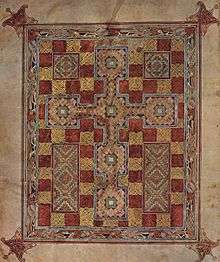
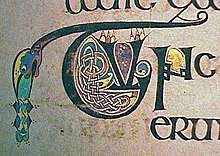
History
The use of interlace patterns had its origins in the late Roman Empire.[1] Knot patterns first appeared in the third and fourth centuries AD and can be seen in Roman floor mosaics of that time. Interesting developments in the artistic use of interlaced knot patterns are found in Byzantine architecture and book illumination, Coptic art, Celtic art, Islamic art, Kievan Rus'ian book illumination, Ethiopian art, and European architecture and book illumination.
Spirals, step patterns, and key patterns are dominant motifs in Celtic art before the Christian influence on the Celts, which began around 450. These designs found their way into early Christian manuscripts and artwork with the addition of depictions from life, such as animals, plants and even humans. In the beginning, the patterns were intricate interwoven cords, called plaits, which can also be found in other areas of Europe, such as Italy, in the 6th century. A fragment of a Gospel Book, now in the Durham Cathedral library and created in northern Britain in the 7th century, contains the earliest example of true knotted designs in the Celtic manner.
Examples of plait work (a woven, unbroken cord design) predate knotwork designs in several cultures around the world,[2] but the broken and reconnected plait work that is characteristic of true knotwork began in northern Italy and southern Gaul and spread to Ireland by the 7th century.[3] The style is most commonly associated with the Celtic lands, but it was also practiced extensively in England and was exported to Europe by Irish and Northumbrian monastic activities on the continent. J. Romilly Allen has identified "eight elementary knots which form the basis of nearly all the interlaced patterns in Celtic decorative art".[4][5] In modern times, Celtic art is popularly thought of in terms of national identity and therefore specifically Irish, Scottish or Welsh.
The Celtic knot as a tattoo design became popular in the United States in the 1970s and 1980s.[6]
Examples
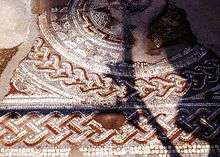 A small part of The Great Pavement, a Roman mosaic laid in AD 325 at Woodchester, Gloucestershire, England
A small part of The Great Pavement, a Roman mosaic laid in AD 325 at Woodchester, Gloucestershire, England- Romanesque cross atop the church of St. Susanna, Santiago de Compostela, Galicia
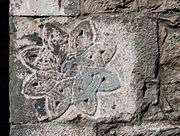 Cahir Abbey, c. 15th century
Cahir Abbey, c. 15th century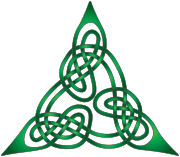 Design influenced by illustration in the Lindisfarne Gospels
Design influenced by illustration in the Lindisfarne Gospels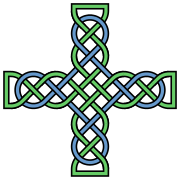 A basic form of a Celtic knotwork cross
A basic form of a Celtic knotwork cross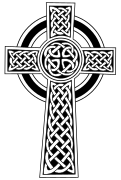 Ornamental version of Celtic "high cross" with decorative knotwork
Ornamental version of Celtic "high cross" with decorative knotwork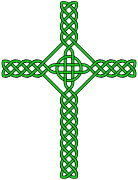 A quasi-Celtic cross made of a large symmetrical knot with a circle interlaced through its center
A quasi-Celtic cross made of a large symmetrical knot with a circle interlaced through its center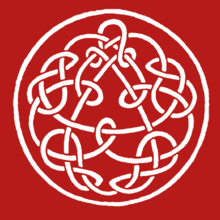 This knotwork by Steve Ball illustrates King Crimson's Discipline and is the logo of Discipline Global Mobile
This knotwork by Steve Ball illustrates King Crimson's Discipline and is the logo of Discipline Global Mobile Slightly modified version of quasi-Celtic knot
Slightly modified version of quasi-Celtic knot Triquetra knot
Triquetra knot Machine generated Zoomorphic Knot
Machine generated Zoomorphic Knot
See also
References
- Trilling, James (2001). The Language of Ornament. World of Art. Thames and Hudson. ISBN 978-0500203439.
- George Bain (1951). Celtic art: The methods of construction. London: Constable Press.CS1 maint: ref=harv (link)George Bain (1973). Celtic Art: The Methods of Construction. Dover Publications, Inc. ISBN 0-486-22923-8.
- Sullivan, Sir Edward (1920). The Book of Kells (Second ed.). "The Studio" Ltd. pp. 39. ISBN 1-85170-035-8.
- Allen, J. Romilly (1904). Celtic Art in Pagan and Christian Times. Methuen & Co. pp. 265. ISBN 1-85891-075-7.
- Ivan, Drew (10 August 2005). "Eight Basic Knotwork Patterns". Archived from the original on 30 January 2018. Retrieved 2007-01-10.
- Shapiro, Ari (25 November 2014). "The American Origins Of The Not-So-Traditional Celtic Knot Tattoo". NPR. Archived from the original on 23 January 2019.
External links
| Wikimedia Commons has media related to Celtic knots. |
- Draw Your Own Celtic Knotwork Comprehensive list of links to both knotwork tutorials and a knotwork bibliography
- Celtic Interlace - An Overview by Stephen Walker, reproduced with permission from Dalriada Magazine, 2000
- Font with Zoomorphic (animal) ornaments GPL Font and generator project
- Celtic Knot Generator Online Celtic knot designer that uses the Knots typeface.
- http://www.hypknotix.com Celtic knots generated algorithmically.
